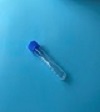MI-Heart ceramides, plasma
MI-Heart ceramides, plasma-994
N-stearoyl-sphingosine
N-nervonoyl-sphingosine
N-lignoceroyl-sphingosine
Cer(d18:1/16:0)
Evaluating for the risk of major adverse cardiovascular events within the next 1 to 5 years.
Patients should not be receiving Intralipid as it may cause false-elevations in measured ceramides
Immediately after collection, mix tube thoroughly by gentle inversion, 8 - 10 times, to prevent clotting
- Spin within two (2) hours of sample collection
- Transfer at least 1.0 mL of plasma into a Screw cap transfer vial/tube (Mayo T914), labelled as EDTA plasma
- Freeze within 8 hours of sample collection
Frozen (preferred) - 30 days
Refrigerated - 24 hours
Ambient - 8 hours
Gross hemolysis
Liquid Chromatography-Tandem Mass Spectrometry (LC-MS/MS)
MI-Heart Ceramide Risk Score:
0-2 Lower risk
3-6 Moderate risk
7-9 Increased risk
10-12 Higher risk
Ceramide (16:0): 0.19-0.36 mcmol/L
Ceramide (18:0): 0.05-0.14 mcmol/L
Ceramide (24:1): 0.65-1.65 mcmol/L
Ceramide (16:0)/(24:0): <0.11
Ceramide (18:0)/(24:0): <0.05
Ceramide (24:1)/(24:0): <0.45
Reference values have not been established for patients who are <18 years of age.
Note: Ceramide (24:0) alone has not been independently associated with disease and will not be reported.
Plasma ceramides predict risk of myocardial infarction, coronary revascularization, acute coronary syndrome hospitalization and mortality within 5 years.
Risk conferred by plasma ceramides is independent of low-density lipoprotein (LDL) cholesterol, C-reactive protein, LDL particles, and lipoprotein-associated phospholipase A2.
Plasma ceramides can be lowered by diet, exercise, simvastatin, rosuvastatin, and proprotein convertase subtilisin/kexin type 9 (PCSK9) inhibitors.

